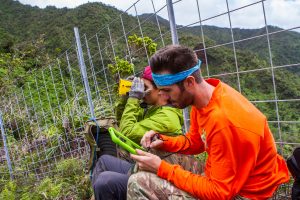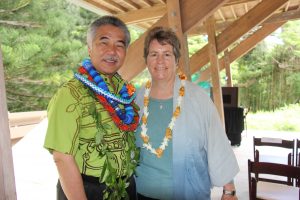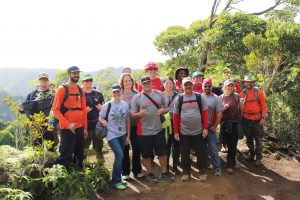Protecting the ‘fabric of our forests’ key to survival
Posted on Apr 24, 2018 in FeaturedEvery time you reach for a glass of water, think about what it took to get it to you. That’s the plea from the staff at the state’s Department of Land and Natural Resources (DLNR) and their watershed partners. Fresh water is something most of us take for granted, yet without it our communities couldn’t survive. Whether we realize it or not, it takes an army of people to make sure water is there when we need it. That includes those who trek into the mountains to do the heavy lifting, day after day, while the rest of us stay warm and dry and just turn on the tap.
That’s also why Governor Ige has prioritized funding for watershed protection, fencing and other initiatives statewide. “We’re trying to maintain the fabric of our forests to keep us in water, provide a home for our native species and protect our coral reefs from erosion,” said the governor. “The threats from climate change keep increasing so we have to invest in protecting what we have.”
Across the state, a network of 10 Watershed Partnerships on five islands work together to protect and prevent the loss of more native forests. These voluntary alliances of public and private landowners maintain protective fences, combat threats of hooved animals such as pigs, goats and deer, control invasive species and plant more native forests. They include 74 private landowners and public agencies that cover over 2.2 million acres.
DLNR director Suzanne Case said this protection involves “continuous nitty-gritty work” that most of us never see. “The people who do this are very passionate about Hawai‘i and very dedicated,” she explained. “It’s cold, it’s wet and it’s dangerous work — building fences, removing invasive plants and animals. Sometimes the workers have to camp out on platforms for a week at a time because the forest floor is so spongy.”
The Ige administration has committed to protecting 30 percent of our priority watersheds by 2030. Currently, 16 percent of these watershed forests are fenced, actively managed and protected, but continued funding and support are needed. “We’re not even talking about all forests, but rather the best, most intact native forests with the richest diversity and complexity to capture water better,” said Case. “We think 30 percent is achievable if we can maintain our public investments.”
Case said we need protection as well as restoration for what has been destroyed. A recent partnership between DLNR, Coca-Cola and the Ko‘olau Mountains Watershed Partnership is helping to protect 1,400 acres of native forest in the Waiawa watershed – a major recharge area for the Pearl Harbor Aquifer, which supplies most of O‘ahu’s drinking water.
A $200,000 grant from Coca-Cola will be used for construction of a 6.6 mile-long protective fence to prevent invasive plants and animals from degrading the surrounding forest. Other monies have come from the Honolulu Board of Water Supply and state watershed capital improvement project funds.
In addition, Coca-Cola employees based in Hawai‘i are volunteering to plant native koa trees in the Ko‘olau Mountains watershed to help restore the forest. The company said the project is its first public-private partnership in Hawai‘i as part of a nationwide commitment to return 100 percent of the water used in its bottling operations across the country.
DLNR’s Division of Forestry and Wildlife is encouraging partnerships for both watershed protection and carbon sequestration. The forest carbon sequestration projects help reduce the greenhouse gas carbon dioxide that contributes to global climate change. The “carbon credits” can be made available to companies and organizations that want to offset their carbon footprint and help provide funding for environmental projects. For more details, go to https://dlnr.hawaii.gov/forestry/frs/initiatives/freshwater-replenishment/ and https://dlnr.hawaii.gov/forestry/frs/initiatives/forestcarbon/.


